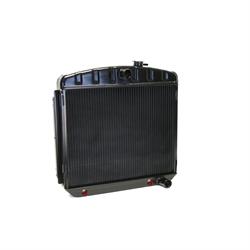Keeping your 1955 Chevy Cool
I’ve had my '55 Chevy Sedan Delivery on the road for about 5 years now. When I got the car, it didn’t have a drivetrain in it and hadn’t been on the road since the early 1980s. To say that I underestimated the amount of work and expense it would ultimately require to get the car running is an understatement. Over the past few years, I have worked out several bugs and replaced parts that I used in a pinch to bring it back to life. This is a story about a shortcut that I wish I would have never taken… a cheapo radiator!
At the time, the swap meet special radiator that I bought seemed like a no brainer. $150 aluminum radiator that looked brand new. How can you beat that? Well, initially I was sure that it was one of the best buys I have ever made. Upon installing the radiator I really didn’t notice anything. It seemed to be working fine with my stock type 4 blade cooling fan. This was in August, so if it stays cool then it has to be able to handle anything right? Fast forward to the following spring… I found myself driving to Las Vegas for the Viva Las Vegas car show. Traffic on Las Vegas Boulevard + hot temperatures + my radiator = the need to add a pusher electric fan to keep the temperatures under control. Well after adding a fan to my setup it seemed like I was dialed in. Fast forward about 3 more years, thousands of miles later and I finally came to a conclusion. My car was running hotter and hotter as time went on. I began to use the pusher fan non-stop, and the temperatures kept creeping higher and higher.
This spring I started to smell coolant once in a while. I figured my radiator cap was weak and letting some coolant past the gasket. After chasing the sweet smell of coolant, I discovered the tank was leaking ever so slightly. Not bad enough to replace the radiator right away, but after the need for a new transmission arose I decided to bite the bullet and replace the radiator at the same time. I know that debris from the trans can make its way into the cooler and contaminate your new fluid and transmission. This was insurance to keep that from happening.
Like I mentioned before, I had been slowly upgrading parts on this car as time went on. Why not upgrade the radiator? I really liked the quality of Dewitts radiators and had installed a few of them into C3 Corvettes I worked on. I opted for the HP series because it features two rows of 1.25” wide tubes and should allow my engine to run as cool as possible. I also chose the Black Ice coating so that the radiator fits the style of my car rather than being raw aluminum.
The new radiator bolted right in place onto my original radiator support. While I was at it I installed some new transmission cooler lines so that my transmission had an entirely new cooling system that was sure to be ultra clean. Something else I had wanted to try out was using de-ionized and distilled water mixed with my coolant. I always knew you were supposed to do that, but I imagine most guys just use tap water in their cooling systems and it works fine. I think this is the biggest victory here. This will keep the inside of the radiator from corroding, thus maintaining the radiators ability to transfer heat. After skipping re-installation of my electric fan ( I just couldn’t mount that fan to the front of my brand new radiator!) I am thoroughly impressed and convinced that this radiator cools MUCH better than the el-cheapo unit that we replaced. I have now driven the car in July and August again, with no electric fan and it is running a cool 180° going down the road. I believe that the old radiator was less efficient at absorbing heat from the coolant and that over time it was getting worse because of the tap water I had been using. Long story short… don’t be afraid to spend a few dollars on quality parts where you need them the most!


